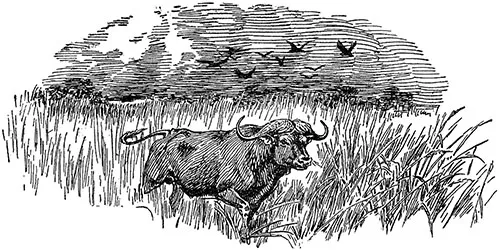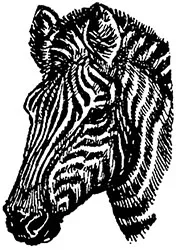![]()
BUFFALO, BUSHFIRE AND WILD DOGS
The summer slipped away. Among the massed evergreens of the woods there stood out here and there bright spots of colour. The careless dabs from Nature’s artist hand; yellow and brown, orange and crimson, all vividly distinct, yet all in perfect harmony. The rivers, fed from the replenished mountains’ stores, ran full and clear. The days were bright, the nights were cold, the grass was rank and seeding, and it was time to go.
Once more the bushveld beckoned us away.
We picked a spot where grass and water were good and waited for the rivers to fall. It was while loitering there that a small hunting party from the fields making for the Sabi came across us and camped for the night. In the morning two of our party joined them for a few days to try for something big.
Two of us started out to try a new quarter in the hilly country rising towards the Berg. My companion, Francis, was an experienced hunter and his idea was that we would find the big game higher up on the breezy hilltops or in the cool shady kloofs running towards the mountains. We passed a quantity of smaller game that morning, and several times heard the stampede of big animals – wildebeeste and waterbuck, as we found by the spoor – but it was absolutely impossible to see them. The dew was so heavy that even our hats were soaking wet, and times out of number we had to stop to wipe the water out of our eyes in order to see our way. A complete ducking would not have made the least difference.
Jock fared better than we did, finding openings and game tracks at his own level. He also knew better than we did what was going on ahead, and it was tantalising in the extreme to see him slow down and stand with his nose thrown up, giving quick soft sniffs and ranging his head from side to side, when he knew there was something quite close, and knew too that a few more toiling steps in that rank grass would be followed by a rush of something which we would never see.
After two hours of this we struck a stream, and there we made somewhat better pace and less noise, often taking to the bed of the creek for easier going. There, too, we found plenty of drinking places and plenty of fresh spoor of the bigger game, and as the hills began to rise in view above the bush and trees, we found what Francis was looking for. Something caught his eye on the far side of the stream and he waded in. I followed and when half-way through saw the contented look on his face and caught his words: ‘Buffalo! I thought so!’
We sat down then to think it out. The spoor told of a troop of a dozen to 16 animals – bulls, cows and calves – and it was that morning’s spoor. Even in the soft moist ground at the stream’s edge the water had not yet oozed into most of the prints. Fortunately there was a light breeze from the hills, and, as it seemed probable that in any case they would make that way for the hot part of the day, we decided to follow for some distance on the track and then make for the likeliest poort in the hills.
The buffalo had come up from the low country in the night on a course striking the creek diagonally in the drinking place. Their departing spoor went off a slight tangent from the stream – the two trails making a very wide angle at the drinking place and confirming the idea that, after their night’s feed in the rich grass lower down, they were making for the hills again in the morning and had touched at the stream to drink.
Jock seemed to gather from our whispered conversation and silent movements that there was work to hand, and his eyes moved from one face to the other as we talked. When we got up and began to move along the trail, he gave one of his little sideways bounds, as if he half-thought of throwing a somersault, and then, with several approving waggings of his tail, settled down at once to business.
Jock went in front. It was best so, and quite safe, for, whilst certain to spot anything long before we could, there was not the least risk of his rushing it or making any noise. The slightest whisper of a ‘hst’ from me would have brought him to a breathless standstill at any moment, but even this was not likely to be needed, for he kept a close watch on my face.
There was, of course, no difficulty whatever in following the spoor. The animals were as big as cattle and their trail through the rank grass was as plain as a road. Our difficulty was to get near enough to see them without being heard. Under the downtrodden grass there were plenty of dry sticks to step on, any of which would have been as fatal to our chances as a pistol shot. Even the unavoidable rustle of the grass might betray us while the buffalo themselves remained hidden. Thus our progress was very slow.
We expected to follow the spoor for several kilometres before coming on the buffalo – probably right into the kloof towards which it appeared to lead – but were, nevertheless, quite prepared to drop on to them at any moment.
Jock moved steadily along the trodden track, sliding easily through the grass or jumping softly and noiselessly over impediments. We followed, looking ahead as far as the winding course of the trail permitted.
To right and left of us stood the screen of tall grass, bush and trees. Once Jock stopped, throwing up his nose, and stood for some seconds while we held our breath. But, having satisfied himself that there was nothing of immediate consequence, he moved on.
I looked at Francis’s face; it was pale and set like marble. His watchful grey eyes were large and wide, as though opened out to take in everything, and those moments of intense interest and expectation were the best part of a memorable day.
There was something near. We felt it. Jock was going more carefully than ever, with his head up most of the time. The feeling of expectation grew stronger and stronger until it amounted to absolute certainty. Then Jock stopped, stopped in mid-stride, not with his nose up ranging for scent, but with head erect, ears cocked, and tail poised – dead still. He was looking at something.
We had reached the end of the grass. Before us there was fairly thick bush mottled with black shadows and patches of bright sunlight in which it was most difficult to see anything. There we stood like statues, the dog in front with the two men abreast behind him, and all peering intently. Twice Jock slowly turned his head and looked into my eyes, and I felt keenly the sense of hopeless inferiority. ‘There it is, what are you going to do?’ was what the first look seemed to say, and the second: ‘Well, what are you waiting for?’
How long we stood thus it is not possible to say; time is no measure of such things, and to me it seemed unending suspense, but we stood our ground, scarcely breathing, knowing that something was there, because he saw it and told us so, and knowing that as soon as we moved it would be gone. Then close to the ground there was a movement – something swung, and the full picture flashed upon us. It was a buffalo calf standing in the shade of a big bush with its back towards us, and it was the swishing of the tail that had betrayed it. We dared not breathe a word or pass a look – a face turned might have caught some glint of light and shown us up. So, we stood like statues each knowing that the other was looking for the herd and would fire when he got a chance at one of the full-grown animals.
My eyes were strained and burning from the intensity of the effort to see, but, except the calf, I could not make out a living thing. The glare of the yellow grass in which we stood and the sun-splotched darkness beyond it beat me.
At last, in the corner of my eye, I saw Francis’s rifle rise, slowly. There was a long pause and then came the shot and wild snorts of alarm and rage. A dozen huge black forms started into life for a second and as quickly vanished – scattering and crashing through the jungle. The first clear impression was that of Jock, who after one swift run forward for a few metres stood looking back at me and waiting for the word to go. But at the sign of my raised hand, opened with palm towards him, he subsided slowly and lay down flat with his head resting on his paws.
‘Did you see?’ asked Francis.
‘Not till you fired. I heard it strike. What was it?’
‘Hanged if I know! I heard it, too. It was one of the big ’uns, but bull or cow I don’t know.’
‘Where did you get it?’
‘Well, I couldn’t make out more than a black patch in the bush. It moved once, but I couldn’t see how it was standing – end on or across. It may be hit anywhere. Expect he’ll lay for us in the track somewhere.’
That is the way of the wounded buffalo – we all knew that – and old Rocky’s advice came to mind with a good deal of point: ‘Keep cool and shoot straight – or stay right home’; and Jock’s expectant watchful look smote me with another memory – ‘It was my dawg!’
A few metres from where the buffalo had stood we picked up the blood spoor. There was not very much of it, but we saw from the marks on the bushes here and there, and more distinctly on some grass further on, that the wound was pretty high up and on the right side. Crossing a small stretch of more open bush we reached the dense growth along the banks of the stream, and, as this continued up into the kloof, it was clear we had a tough job before us.
Animals when badly wounded nearly always leave the herd and very often go downwind so as to be able to scent and avoid their pursuers. This fellow had followed the herd upwind, and that rather puzzled us.
A wounded buffalo in thick bush is considered to be about as nasty a customer as anyone may desire to tackle. Its vindictive indomitable courage and extraordinary cunning are a very formidable combination, as a long list of fatalities bears witness. Its favourite device – so old hunters will tell you – is to make off downwind when hit, and, after going for some distance, come back again in a semicircle to intersect its own spoor, and there under good cover lie in wait for those who may follow up.
The huge black beast is able to hide itself so effectually that it can charge from a distance of a dozen metres on to those who are searching for it.
The secret of it seems to lie in two things. First, ab...



